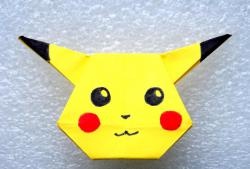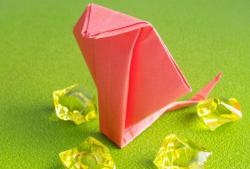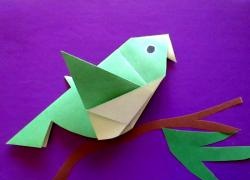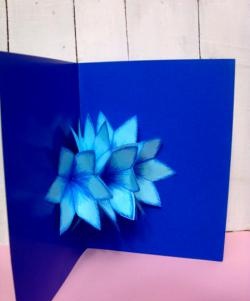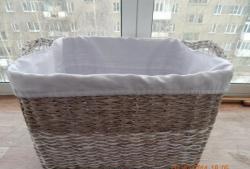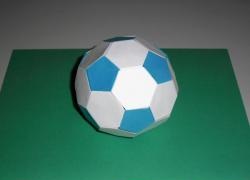Flower panel "Gladiolus with foxglove"
In order to decorate the room and have a good time, you can make a flower panel using the technique origami from paper. Origami gladiolus bushes turn out very beautiful and go well with foxglove bushes. To make them we will need from five to seven days, and the instructions for making them can be understood by children from seven or eight years old.
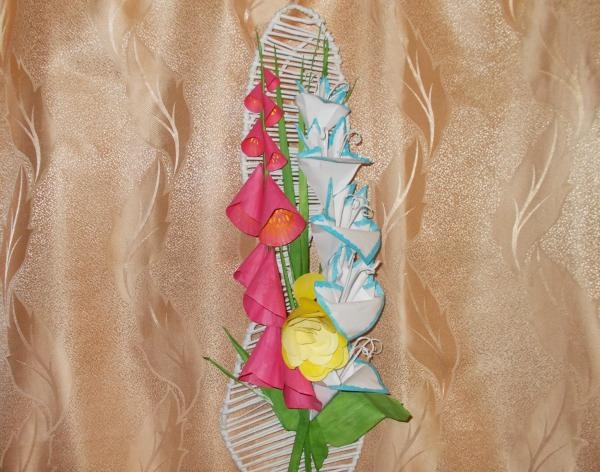
To work on the craft we need:
- Pencil;
- White paper (we used sheets of A4 paper);
- Gouache or watercolor paints in blue, yellow, pink and green;
- Brush and container with water;
- PVA glue;
- Scissors;
- Knitting needle or ballpoint pen;
- Thread or wire with a needle.
Starting work, we take a blank sheet of paper and cut out a square from it, folding the top edge of the paper to the bottom opposite side:
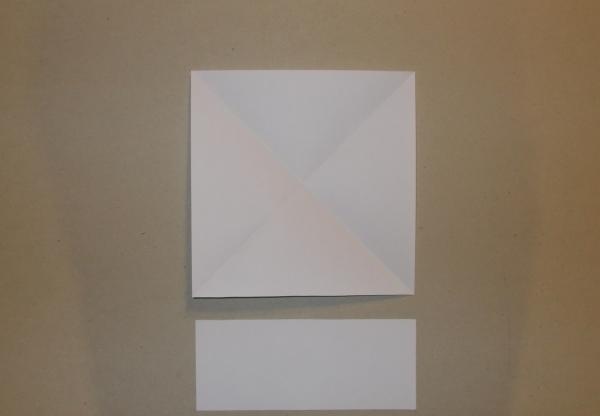
When folding the basic “double square” shape, you need to fold the sheet four times: twice on one side and twice on the other:
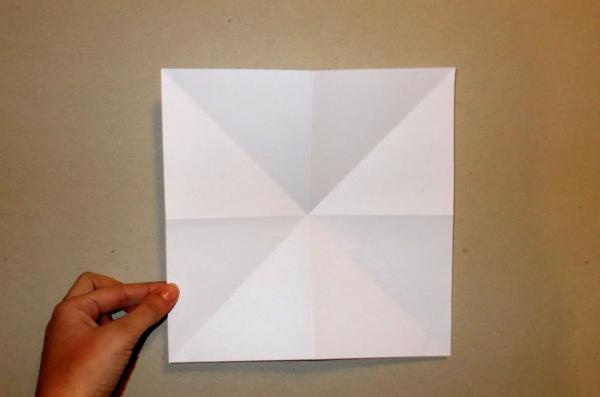
Now we unfold the square sheet and fold it into a double square shape:
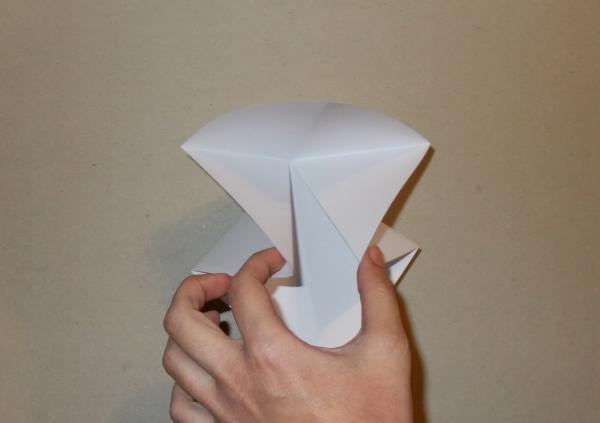
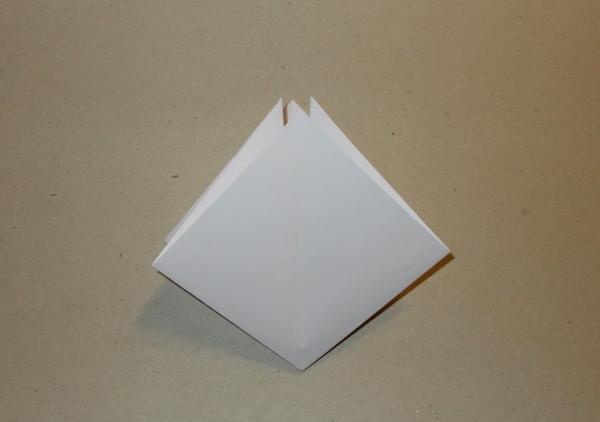
Now the upper right and left sides of the resulting rhombus need to be bent and folded towards the middle, and then returned to their previous position. This must be done to mark the exact fold lines:

Having returned both sides of the figure to their previous position, they need to be bent inward:
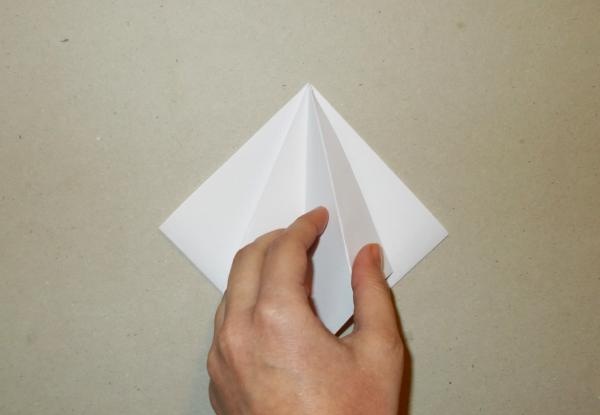
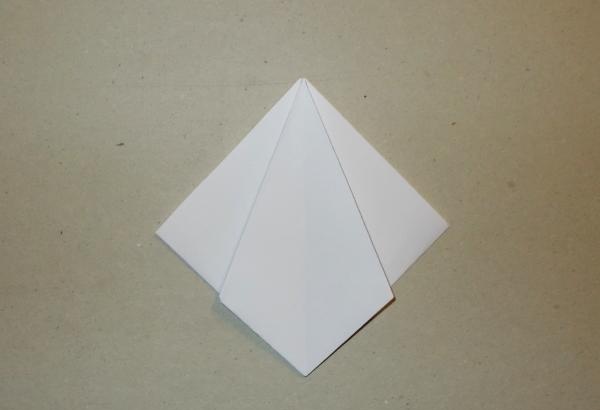
Next, we turn the figure over and bend the lower sides towards the middle, after which, also returning them to their previous position, we fold them inside the figure:
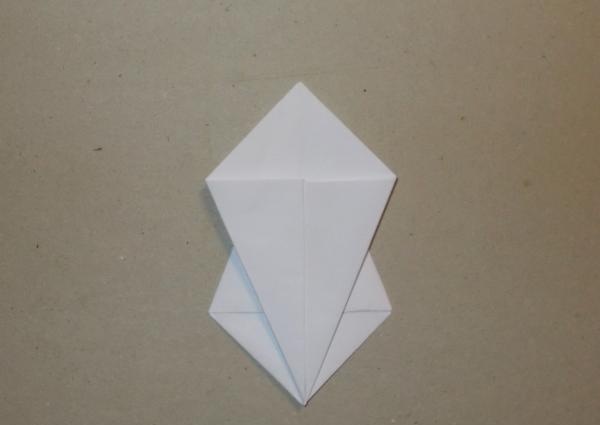
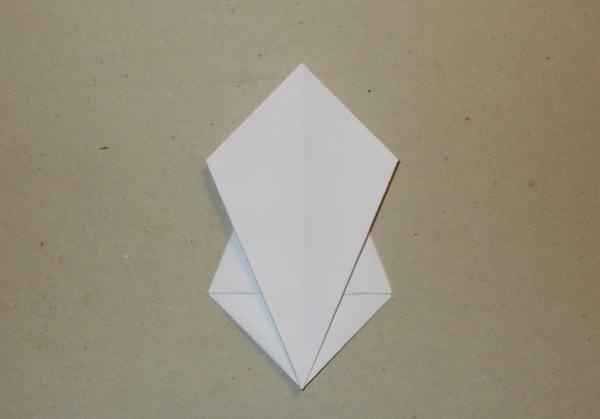
Next, the lower side triangles, which have now begun to stand out, need to be bent upward:
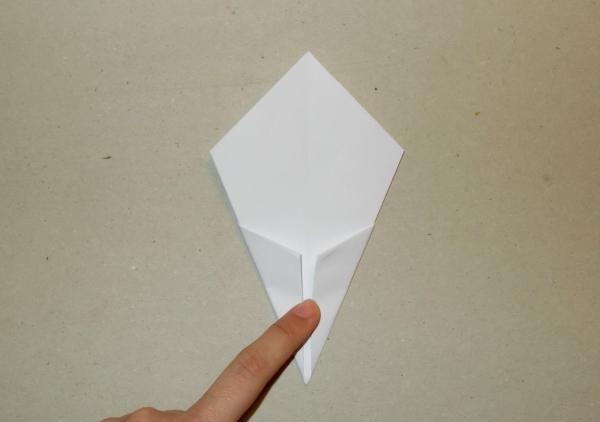
After this, you need to fold them inside the figure and turn it over:
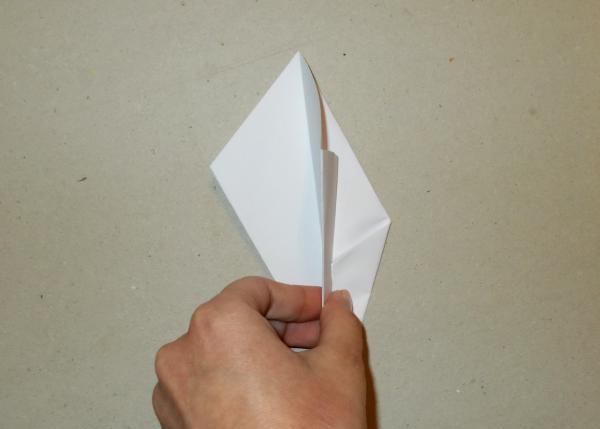
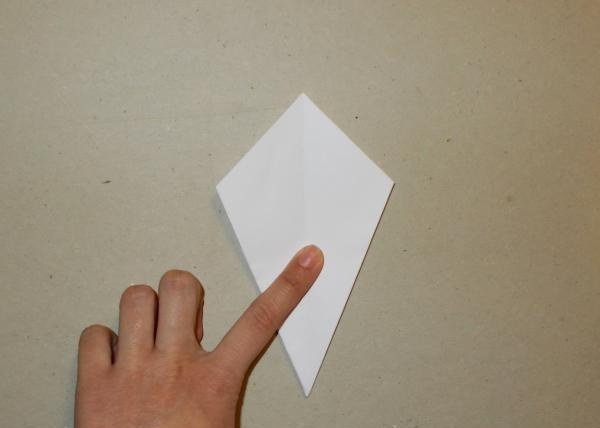
Now we need to bend the top large sheet of the figure forward, and bend the three rear “petals” in the opposite direction, after which, opening them slightly, bend their side edges closer to the middle (this will prevent the petals from folding back):
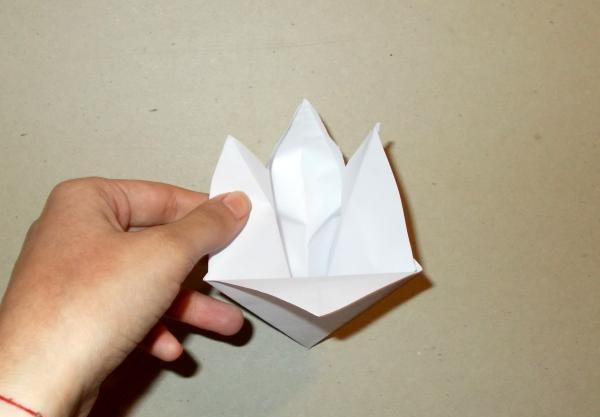
To make the lower petal of the finished flower larger and the finished flower more magnificent, you need to take part of the two upper side petals for it, folding the figure in such a way as shown in the following photo:
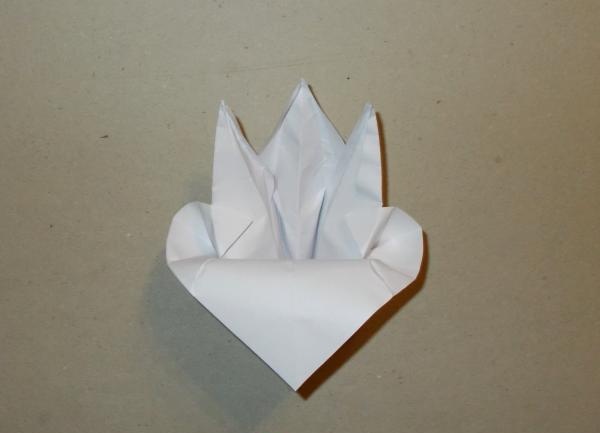
Now that’s it - our gladiolus, made of paper using the origami technique, is ready. We need to make five of these flowers, and then we will start creating the stem and leaves.
To make the stem, we will need paper 2.5 - 3 times longer than the one taken to work with the flower; you can take the paper left over after working with flowers:
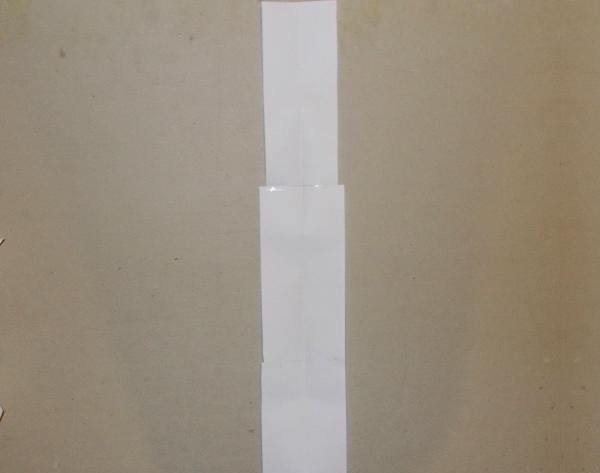
From the glued rectangle you need to cut out a long triangular shape and fold it in half, after which its sides are folded towards the middle; and then, turning the small triangles at the lower ends in the opposite direction, fold the lower ends themselves up:
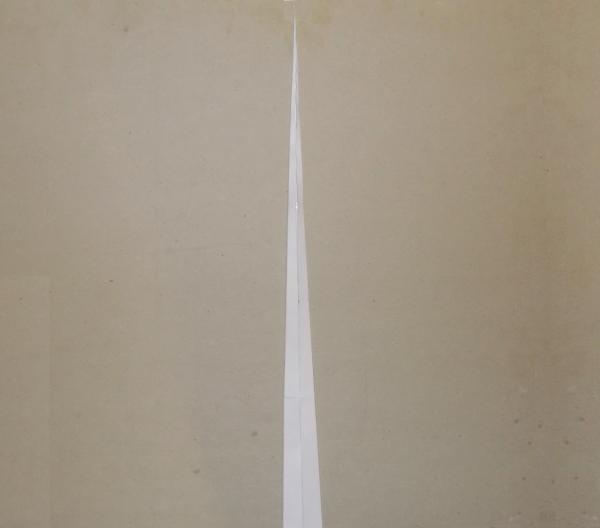
Next, bend the side edges from the middle of the figure (not from the top) as shown in the photo:
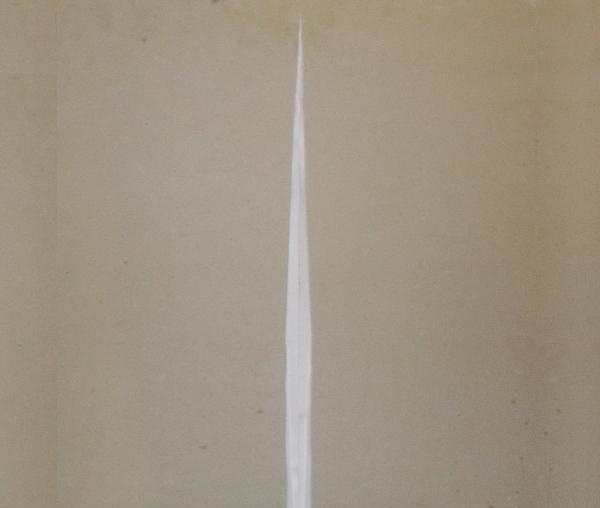
After this, fold the entire sheet in half:
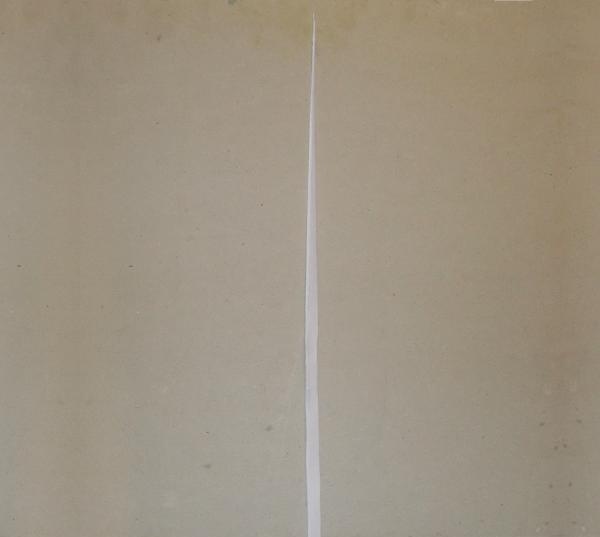
Now we need to take one of the cut triangles and first bend its sides to the middle, then fold it in half and insert it inside the previous one.

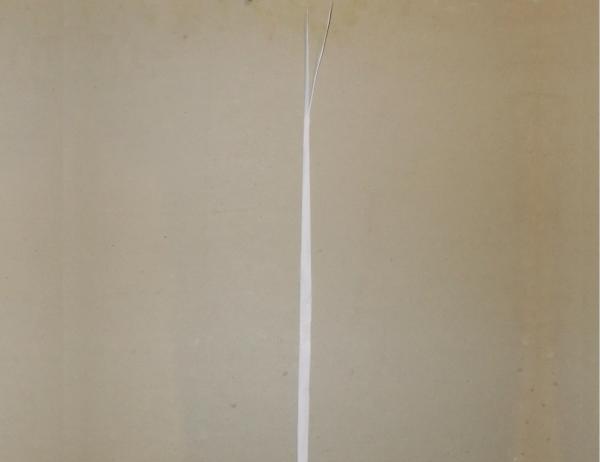
We need to make three more such sheets. Next, the flower shapes need to be glued to the longitudinal groove of the sheet from the side where the smaller sheet is glued. In order for the figures to stick more securely, they can be compressed using clothespins:
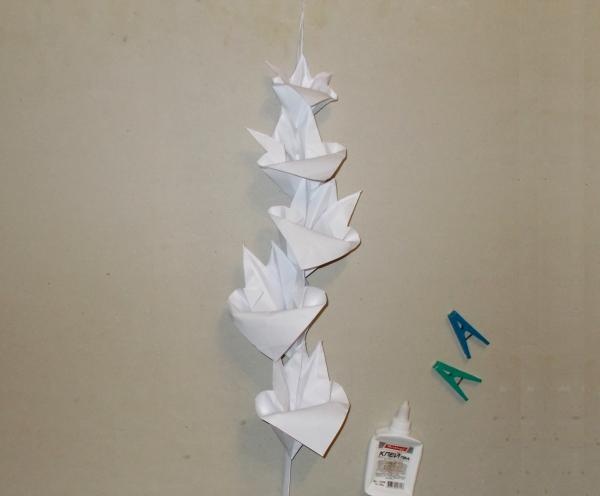
When all the flowers and leaves are glued, the craft can be painted:
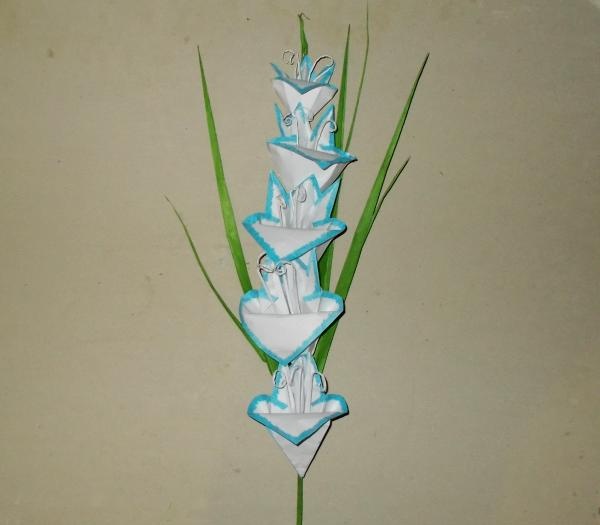
After this, our gladiolus bush is ready and we can begin making foxgloves. For it, we need to divide two sheets of white paper into eight parts, and from the third sheet we need to make the same pointed stem as for the gladiolus:
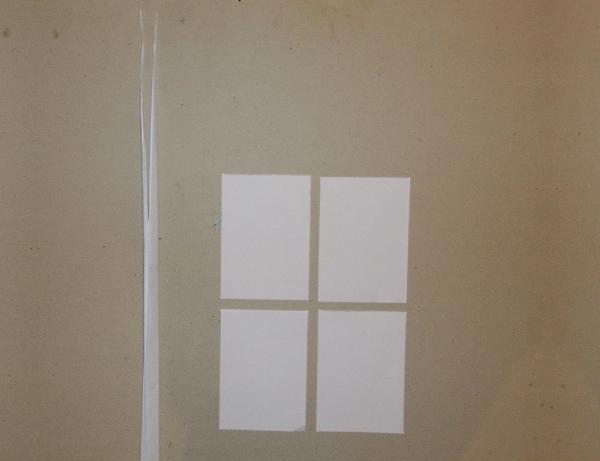
From the cut parts of the leaf we need to glue the shapes of foxglove flowers in the shape of cones and glue them to the paper stem:

Once the glue has hardened, the flowers can be painted:
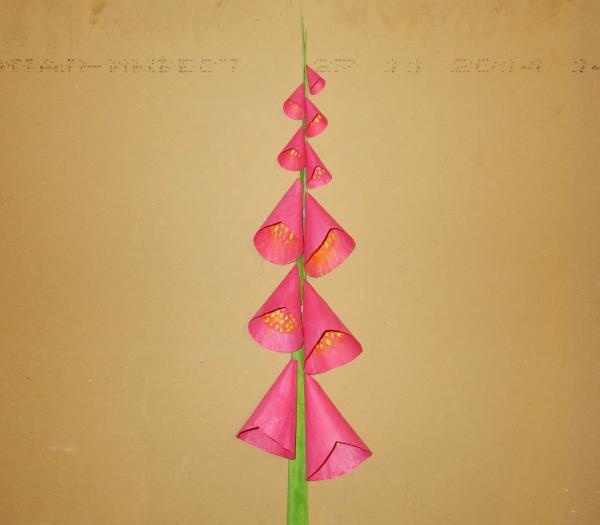
The leaves for the foxglove need to be made according to the model for making the stem, but wider (without bending the sides), and also glued and painted:

Having made two bushes (with a total of 16 flowers), we decided to add another flower to them, assembled from seven parts of different sizes, glued together:
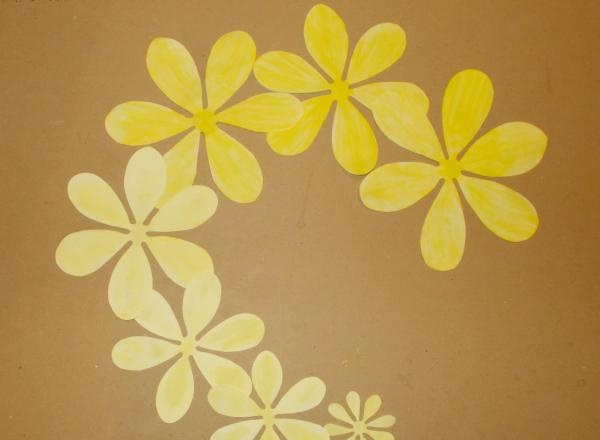
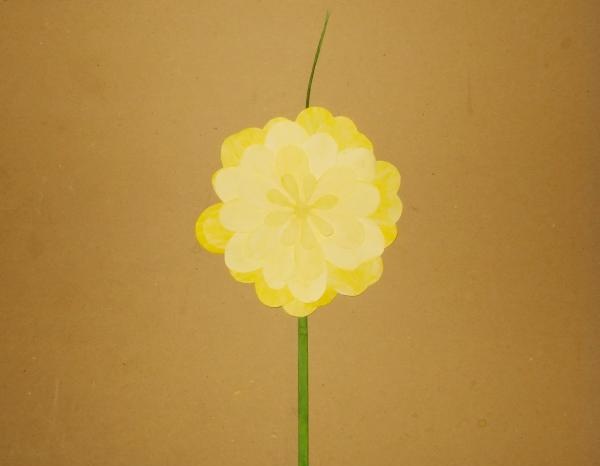
This flower turned out to look like a yellow camellia. After gluing all its parts, you will need to trim the petals (cut off their excess sections), and the petals can be folded and pressed to the middle, after which they can be opened to form a bud.
All finished flowers should be collected together and tied with ribbon. There is a ribbon behind the large camellia flower, but it is not visible:
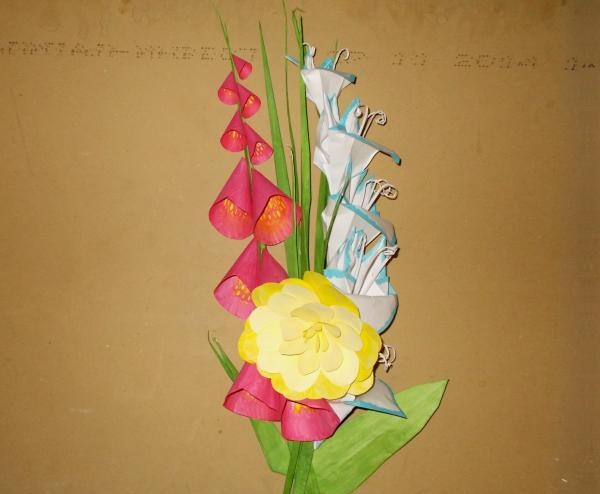
Next, we take A4 paper and cut it into thin strips, which we twist into tubes using a ballpoint pen and glue them together:
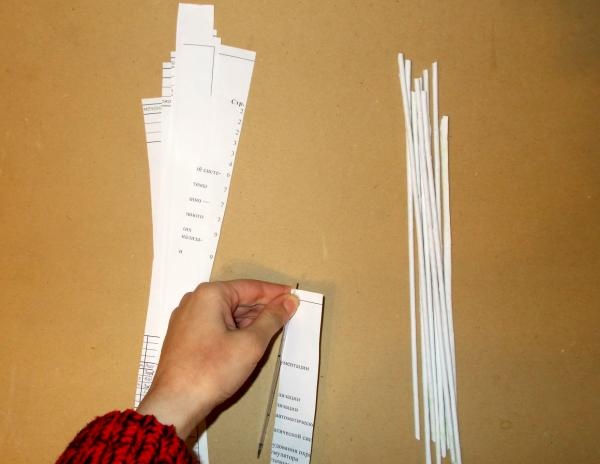
Each tube must have a narrow beginning and a wide end, so that another, narrower one can be glued into the wide end of one tube. Having connected 4 - 5 tubes in this way, we twist them and get a figure-eight figure:
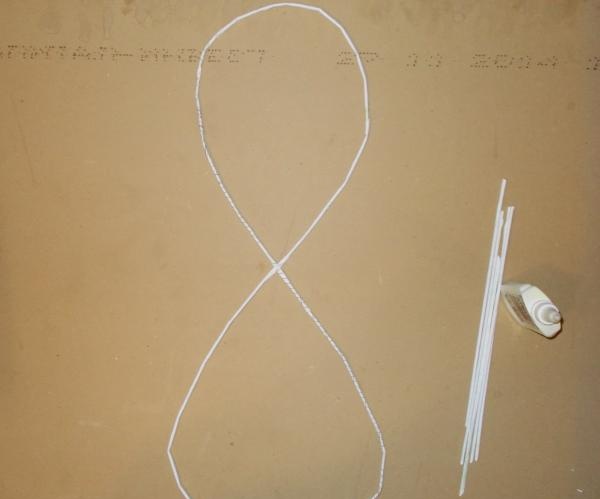
We need to process (wrap) the resulting figure with other tubes several times to make it stronger. You can pass several tubes through the middle crafts:
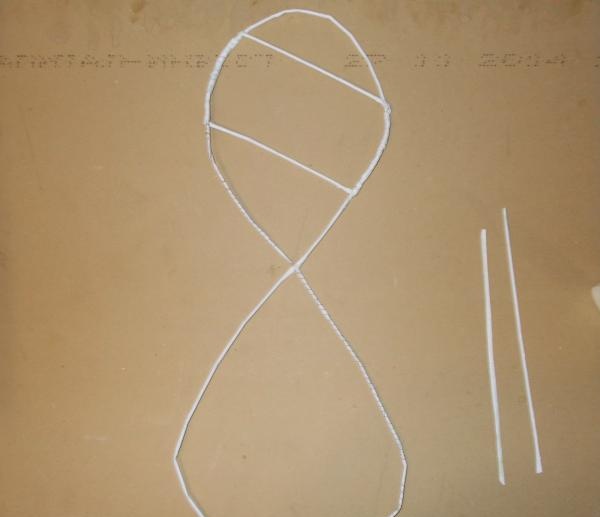
When we need to start processing the second time, we will weave a little differently than the first time: having made several turns of a braided tube on one side, we will draw it to the other and, having also made a few turns there, we will draw the tube to the opposite side - and so we will wrap it around the entire craft until the end. If the tube runs out, you will need to insert a new one, and to prevent the weaving from coming apart, you can use a clothespin:
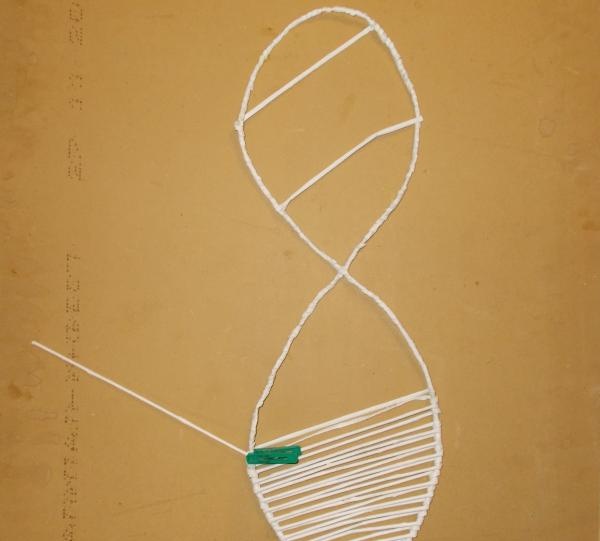
After finishing working with the tubes, our craft looks like this:
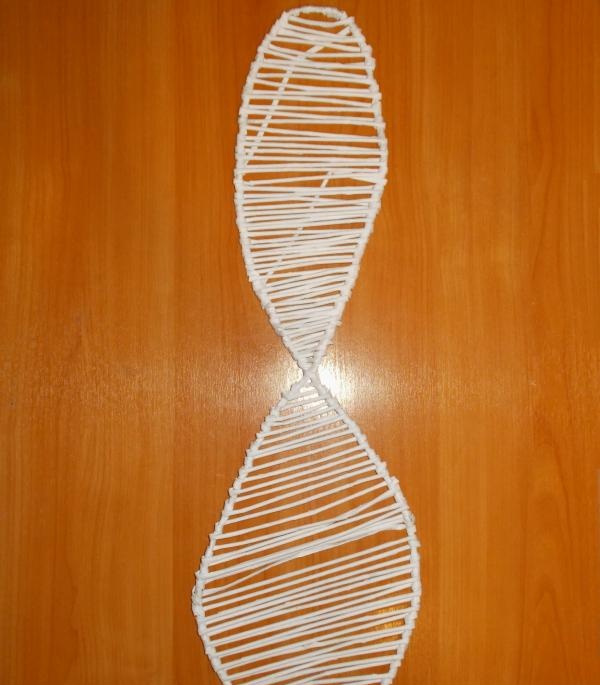
It can be covered with a layer of transparent or white acrylic varnish, if available, and flowers can be attached.
Flowers can be glued, but it will be more reliable to sew them using wire or thread with a needle. And after that, our paper origami flower panel is ready:
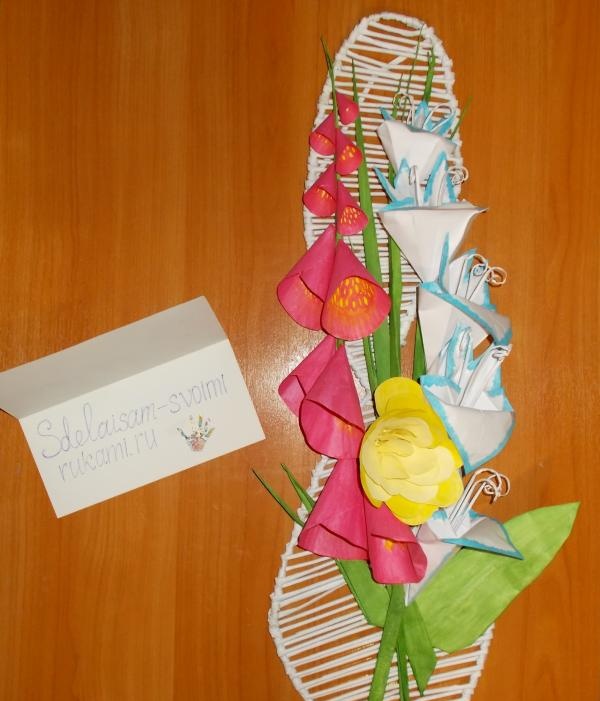
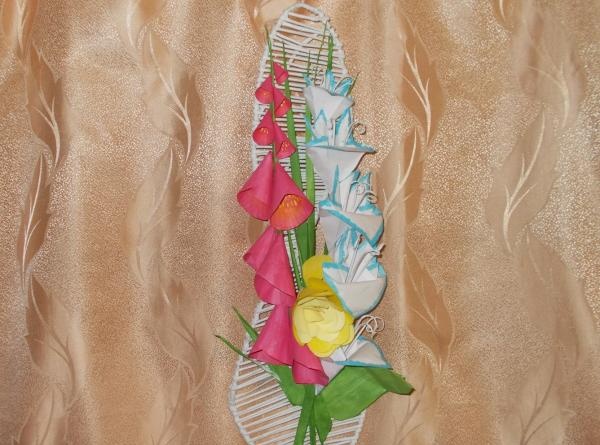
Sincerely, Vorobyova Dinara.

To work on the craft we need:
- Pencil;
- White paper (we used sheets of A4 paper);
- Gouache or watercolor paints in blue, yellow, pink and green;
- Brush and container with water;
- PVA glue;
- Scissors;
- Knitting needle or ballpoint pen;
- Thread or wire with a needle.
Starting work, we take a blank sheet of paper and cut out a square from it, folding the top edge of the paper to the bottom opposite side:

When folding the basic “double square” shape, you need to fold the sheet four times: twice on one side and twice on the other:

Now we unfold the square sheet and fold it into a double square shape:


Now the upper right and left sides of the resulting rhombus need to be bent and folded towards the middle, and then returned to their previous position. This must be done to mark the exact fold lines:

Having returned both sides of the figure to their previous position, they need to be bent inward:


Next, we turn the figure over and bend the lower sides towards the middle, after which, also returning them to their previous position, we fold them inside the figure:


Next, the lower side triangles, which have now begun to stand out, need to be bent upward:

After this, you need to fold them inside the figure and turn it over:


Now we need to bend the top large sheet of the figure forward, and bend the three rear “petals” in the opposite direction, after which, opening them slightly, bend their side edges closer to the middle (this will prevent the petals from folding back):

To make the lower petal of the finished flower larger and the finished flower more magnificent, you need to take part of the two upper side petals for it, folding the figure in such a way as shown in the following photo:

Now that’s it - our gladiolus, made of paper using the origami technique, is ready. We need to make five of these flowers, and then we will start creating the stem and leaves.
To make the stem, we will need paper 2.5 - 3 times longer than the one taken to work with the flower; you can take the paper left over after working with flowers:

From the glued rectangle you need to cut out a long triangular shape and fold it in half, after which its sides are folded towards the middle; and then, turning the small triangles at the lower ends in the opposite direction, fold the lower ends themselves up:

Next, bend the side edges from the middle of the figure (not from the top) as shown in the photo:

After this, fold the entire sheet in half:

Now we need to take one of the cut triangles and first bend its sides to the middle, then fold it in half and insert it inside the previous one.


We need to make three more such sheets. Next, the flower shapes need to be glued to the longitudinal groove of the sheet from the side where the smaller sheet is glued. In order for the figures to stick more securely, they can be compressed using clothespins:

When all the flowers and leaves are glued, the craft can be painted:

After this, our gladiolus bush is ready and we can begin making foxgloves. For it, we need to divide two sheets of white paper into eight parts, and from the third sheet we need to make the same pointed stem as for the gladiolus:

From the cut parts of the leaf we need to glue the shapes of foxglove flowers in the shape of cones and glue them to the paper stem:

Once the glue has hardened, the flowers can be painted:

The leaves for the foxglove need to be made according to the model for making the stem, but wider (without bending the sides), and also glued and painted:

Having made two bushes (with a total of 16 flowers), we decided to add another flower to them, assembled from seven parts of different sizes, glued together:


This flower turned out to look like a yellow camellia. After gluing all its parts, you will need to trim the petals (cut off their excess sections), and the petals can be folded and pressed to the middle, after which they can be opened to form a bud.
All finished flowers should be collected together and tied with ribbon. There is a ribbon behind the large camellia flower, but it is not visible:

Next, we take A4 paper and cut it into thin strips, which we twist into tubes using a ballpoint pen and glue them together:

Each tube must have a narrow beginning and a wide end, so that another, narrower one can be glued into the wide end of one tube. Having connected 4 - 5 tubes in this way, we twist them and get a figure-eight figure:

We need to process (wrap) the resulting figure with other tubes several times to make it stronger. You can pass several tubes through the middle crafts:

When we need to start processing the second time, we will weave a little differently than the first time: having made several turns of a braided tube on one side, we will draw it to the other and, having also made a few turns there, we will draw the tube to the opposite side - and so we will wrap it around the entire craft until the end. If the tube runs out, you will need to insert a new one, and to prevent the weaving from coming apart, you can use a clothespin:

After finishing working with the tubes, our craft looks like this:

It can be covered with a layer of transparent or white acrylic varnish, if available, and flowers can be attached.
Flowers can be glued, but it will be more reliable to sew them using wire or thread with a needle. And after that, our paper origami flower panel is ready:


Sincerely, Vorobyova Dinara.
Similar master classes
Particularly interesting
Comments (0)


